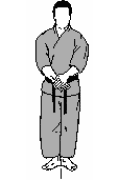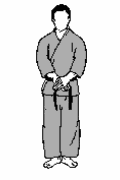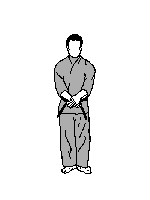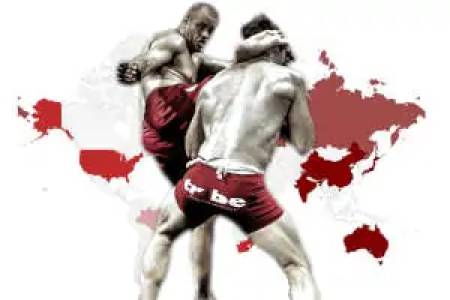Goju-Ryu Karate is a traditional style of Karate that was pioneered by Chōjun Miyagi Sensei. It translates to Hard-Soft style and requires dedicated and earnest practice to understand this principle which permeates throughout this Martial Art.
In most traditional Goju-Ryu Karate Schools, the syllabus is comprised of 13 kata. As this is a Martial Art that I spend much of my time training, I wanted to explore these kata and share the knowledge that I have acquired of these with you. I’d like to share the important aspects of fighting and self-defence that one can learn from each kata.
Before I continue, I’d like to make it clear that your training will be incomplete if you only train kata. Karate Karate comprises of Kihon (basics), Kata (forms) and Kumite (fighting/ sparring). These are ingredients that will help create the complete meal to nourish you as a Karate practitioner. If you train all these aspects well, the fruits of this training will permeate into each other and help you become a complete and well-rounded Martial Artist. As a Karate practitioner, improving your fighting or sparring abilities will also improve your performance in Kata and vice-versa. The only requirements for this is deliberate and practical practice.
So, let’s get into the 13 Goju-Ryu Karate Kata …
Gekisai Dai Ichi – “Attack and Destroy One”
Gekisai Dai Ichi is a highly intense kata that involves dynamic sequences which emphasise the interchange between defence and attack in extremely fluid sequences of techniques. This kata is comprised of a variety of strikes, blocks and stances and helps the practitioner understand how to better align the body, maintaining good balance and coordination. The dynamic nature of the kata helps the karateka understand how to exert full body power as they transition from one technique to another. As its name suggests, this kata teaches the practitioner to quickly overwhelm an opponent using the principle that offence is the best defence. All techniques in Gekisai Dai Ichi are performed predominantly with a closed fist which is the most visible difference between its counterpart Gekisai Dai Ni.
Gekisai Dai Ni – “Attack and Destroy Two”
Gekisai Dai Ni is almost identical to Gekisai Dai Ichi and expands on the techniques learnt from its predecessor. It contains the same sequences of movement, intensity, and rhythm. The major difference between these two kata is that Gekisai Dai Ni emphasises open-handed defensive techniques. Open-handed defensive manoeuvres suggest that one may grab the opponent on receiving an attack and redirecting it.

Saifa – “Rip and Tear Apart”
Saifa emphasises close quarter combat and grappling techniques. In this kata, the practitioner grabs or takes hold of their opponents and simultaneously deals destructive blows to the head and collar bone region. The strikes in Saifa are explosive and precise, with a focus on concentrating energy on specific targets. Saifa is performed in an extremely relaxed manner and the practitioner learns to generate tremendous power within confined space while being completely relaxed. Smooth, fluid and uninterrupted flow of techniques are showcased in this kata, enabling the practitioner to chain together offensive techniques seamlessly. Through well-timed and dynamic full body transitions, the practitioner can unbalance and destroy opponents aggressively.

Seiyunchin – “Control, Suppress and Pull”
Seiyunchin is a kata that imparts grappling techniques and defensive manoeuvres against common grappling attacks like choke holds and bear-hug holds. The kata also employs techniques to unbalance the opponent using foot sweeps and transitions to low stances. The low stances help develop leg strength, balance, and stability. This, in turn, allows the practitioner to maintain a solid base from which to execute grappling techniques and generate power. Seiyunchin features throws, take-downs and close quarter striking with movements ranging from slow and controlled to fast and explosive. Transitioning between controlled and explosive techniques in this kata is characteristic of Goju-Ryu karate.

Shisochin – “4 Directions of Attack or Conflict”
Shisochin applies striking, joint-locks, takedowns and throwing techniques in four directions. The practitioner learns to transition from one direction to another with grace and agility. Personally, I imagine defending against four attackers who are positioned to the front, back, left, and right when performing this kata. The four directions are very clearly depicted in this kata when the practitioner performs the four shotei (open-handed palm strikes) in the four directions. The shotei are also performed simultaneously with a parry or deflection of an opponent’s front-kick which introduces the concept of simultaneous defence and attack.

Sanseiru – “36 Hands”
Sanseiru introduces many new types of in-fighting techniques such as the use of elbows in combination with the low side kick (kansetsu geri) which aims to break the knee of the opponent. The kata also teaches defensive patterns against a flurry of attacks and joint locks. The sliding movements within the kata that end in strikes emphasise closing the distance and striking with the power of the entire body.

Seipai – “18 Hands”
Circular movements and transitions are very dominant in Seipai. The Karate practitioner learns a variety of joint lock and overhead throwing attacks in this kata. The throwing techniques are executed whilst in motion to allow the practitioner the momentum needed to pick the opponent up. In this way energy is conserved and throwing is efficient. The kata also consists of a variety of close- and long-range combinations which teaches the practitioner how to fight fluidly between these ranges. One is introduced to dynamic and circular transitions which help to evade attacks in close fighting situations.

Kururunfa – “Holding Ground”
Kururunfa has a strong emphasis on grappling which includes catching techniques to take control of an opponent while shifting rapidly to control the opponent’s centre of gravity. This kata also comprises of techniques to defend against common grappling situations. The kata epitomises the Go (Hard) Ju (Soft) nature of its style. The over-arching concept of Kururunfa is to seize or take hold of an opponent and thereafter devastate the opponent with a sudden strike to end the confrontation decisively. The practitioner also learns the art of remaining patient and to strike at the most optimal opportunity to receive a victorious and decisive outcome. The feel of Kururunfa is very similar to that of Saifa where the practitioner generates large amounts of power through relaxation and the execution of techniques using “muchimi” or a “heavy stick” movement.

Seisan – “13 Hands”
Seisan is believed to be one of the oldest Goju Ryu kata and is present in many other styles of Karate.
This kata showcases some very powerful techniques for close range fighting such as grabs, locks, and short-range strikes. The practitioner becomes adept to the skill of generating power from a short range. Its angular movements and transitions help the practitioner understand the concept of evading direct attacks and countering from different angles.

Suparinpei – “108 Hands”
Suparinpei is Goju Ryu’s most advanced kata. It is a very lengthy kata with a combination of techniques repeated in eight major directions (N, S, E, W, NE, NW, SE, SW)
It has countless applications or bunkai with many hidden elements. The kata has many mawashe uke which are versatile double circular blocks. These can be used to parry a flurry of strikes as well as grab hold of an opponent’s arm and simultaneously deliver a strike of your own.
Suparinpei also comprises of quick turns and even showcases a jumping forward kick (tobi geri).

Sanchin – “3 Battles”
Sanchin or the 3 battles is a physically and mentally demanding kata. The first of the “heishu” kata in Goju-Ryu requires full body muscular contraction with coordinated intense breathing. The deep inhalation and full exhalation are known as ibuki breathing. Ibuki breathing is diaphragmatic breathing which engages the core muscles to maximise the intake of oxygen and build internal energy. The practitioner must coordinate the body, technique, and breath in Sanchin kata. This allows the practitioner to connect the body and mind through breath.
Sanchin is a complex kata in which ones learns to:
- form a stable stance or base
- builds internal energy (ki)
- control breath
- strengthen the entire body by contracting all the musculature through the principle of irradiation.
- connect body and mind
- mental resiliency
- perfect posture and body alignment
- massage the bodies lymph nodes to get rid of bodily toxins
The 3 battles of Sanchin are metaphorical representations of the struggles that a karateka faces and must overcome:
- Physical Battle – the physical strength, endurance and tension that Sanchin demands during performance of the kata
- Mental Battle – focus, discipline and resilience that the karateka must possess to persevere through the challenging kata
- Spiritual Battle – development of character of the practitioner and cultivation of spiritual attributes such as humility, integrity, and perseverance.
Sanchin Ichi
This version of Sanchin kata is completed in a single direction with no turns.
Sanchin Dai Ni
This version of Sanchin kata is completed in 2 directions forward and backwards with 180 degree turns. The turns are completed with fast impactful blocks which differ to the slow and controlled tempo of the rest of the kata.

Tensho – “Turning Palms”
Tensho is the second of the “heishu” kata. Tensho compliments Sanchin and both kata illustrate the defining Goju Ryu principle of hard and soft. The techniques, breathing and execution of Sanchin is hard and external. Tensho on the other hand is soft and internal. The techniques are light and flowing and the breathing in the kata is internalised with focus on the internal energy pathways.
Although Sanchin and Tensho seem like contrasting katas, both help to bring unity to the body, mind, and Spirit. In this way, both katas complement each other and help the Karateka acquire the same skills through different approaches.
Tensho’s flowing, circular and relaxed movements heighten the awareness of internal energy and allows the practitioner to cultivate their own internal ki. Internal energy cultivation enhances overall vitality and promotes mental, physical, and spiritual well-being. Consistent training in Tensho allows the karateka to maintain a constant, relaxed, and smooth flow of energy in their movements. This helps them to avoid unnecessary tension and stiffness and enables them to use energy efficiently.
In addition to internal energy awareness, the practitioner also develops their sensory awareness. This allows them to detect subtle changes in their surroundings including the movements and intentions of those around them. The heightened sensory awareness allows the practitioner to anticipate and react swiftly to threats.
The principles imparted through Tensho are applied during kakie training of Goju Ryu. In this exercise, the karateka learns to sense, apply, and manipulate the energy of their opponent. As their opponent pushes towards them, they have an opportunity to absorb and redirect the opponent’s energy back to the opponent through circular and flowing movement. This offers valuable lessons in self-defence where practitioners learn to flow with an opponent’s force and redirect it to create openings for counterattacks. As such Tensho helps the practitioner to adapt and evade when necessary.

Goju Ryu Kata Demonstration
Final Thoughts
As you can see, kata is much more than the sum of all its parts. Each one is unique with a rich amalgamation of concepts, philosophies, history, fighting strategies and approaches to combat. The applications or “bunkai” of kata are also numerous which makes it a versatile training tool for the Karateka. I gain deeper insight into kata the more I practice. So, there is no doubt that I will return to capture these insights as the kata reveals them to me.
More on Martial Arts

4 Strategies to Improve your Speed and Timing
Sunday, 28 August 2022 17:22An effective striker is one who has incredible distance management, speed, and timing. It is of little use to execute a perfect punch or kick if you are too far away from your opponent. To land your...

How Martial Arts changed my Life
Thursday, 07 October 2021 17:09As a Martial Artist, I have had many years to understand Martial Arts. I know how it has benefited me and what I use it for. I have also been an avid observer of others who pursue Martial Arts and...

Travel for Martial Arts
Thursday, 07 October 2021 16:59There are so many benefits of travel. You broaden your mind by learning about other cultures, acquire new life experiences and discover new things and places. Imagine combining this with some...
